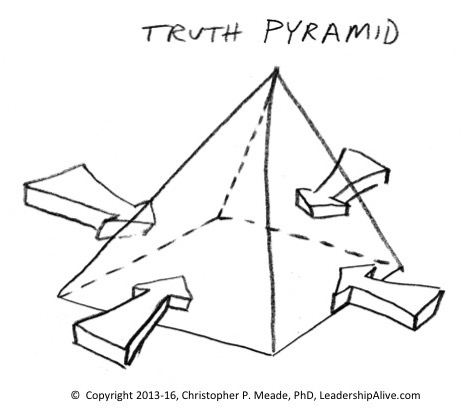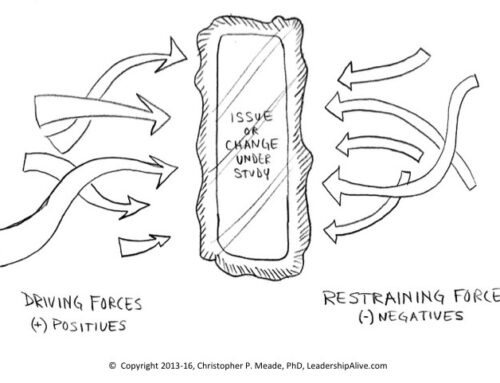Overcoming The Pitfall of One-Dimensional Thinking

Getting Beyond The First Right Answer
Leaders who are open to new perspectives are often able to arrive at better and more complete solutions to the problems they encounter in life and work. Yes, the answers to some questions are black and white, yes and no, plain and simple. But for many other questions, quick fixes, memorized sound byte responses, and one-dimensional conclusions don’t always fix systemic and multi-layered issues and problems. Bottom line: Multi-dimensional problems can’t be solved long-term with one-dimensional solutions.
One-Dimensional thinking
As a kid, I remember when I thought I had the world of one-dimensional mathematics figured out. Pat answers to my multiplication and division flash cards seemed manageable: memorize the sequence and regurgitate your answer, fast and painlessly. Then a teacher introduced me to the world of math word problems. She added a whole new dimension of complexity to my very small world.
 Whole Picture, Whole Solution
Whole Picture, Whole Solution
Life is more like a word problem than it is a flash card with an easy and predicable answer. Sometimes arriving at “the whole truth” about something is being able to look at something from a different angle. Many times a correct answer has more than one component or side to it. One of the benefits of a high-functioning team is that it helps us get beyond one-dimensional thinking and arriving at one-dimensional conclusions. Sometimes answers are multi-dimensional. They have several layers of complexity or sides to them. One side isn’t the “whole truth.” Like the distinct sides of a pyramid, truth, or what is correct, is sometimes all of the sides at once. It’s when we are able to step back and see the whole picture that a whole solution can be reached. Working in the context of community helps generate and suggest whole solutions.
Multi-Dimensional Challenges Need Multi-Dimensional Solutions
Wise people do their best to suspend making a final judgment about something or someone until they have the full story. Usually, the pieces don’t all show up at the same moment. As we work together as a team we are empowered to see multiple sides to an issue. It’s not that any one side is wrong; it’s just that it’s an incomplete picture. We need to be able to understand, hear, or see all of the sides in order to make our best and full decision. That’s why multi-dimensional problems can’t be solved long-term with one-dimensional solutions.
Arriving at the Whole Truth or Solution
As kids when we got in trouble as a pack of brothers, we were brought in one by one to tell our dad our side of the story. Each brother brought their own version and pleaded their case! Each brother’s story was usually different. Each of us told the truth according to our interpretation of the particular event. After my dad had heard all four sides of the story, he would then make a multi-dimensional decision, which usually meant that all four of us got a spanking! Each brother was partially right, and some more right than others, but all the brothers had an element of truth to their side. My dad needed to see the “complete picture” before he could discern the “whole truth.”
Multiple Voices and Diverse Perspectives
Not only is this principle dependable in resolving complex family issues, but it’s true in the world of business and leadership, too. If we focus on only one portion of the equation, we become lopsided and one-dimensional. The whole truth is all parts working in concert together. Much like that of a “pyramid” the answer is not one side, but rather all of the sides coming together as one complete object or picture.  Too often, we carve life up into discrete slices and categories and fail to see the situation in its completeness. Therefore, we arrive at incomplete solutions because our diagnosis was depth-less, cursory and one-dimensional. To be a leader that consistency arrives at the “whole truth” in our decision-making, we often will need to put ourselves around multiple voices and diverse perspectives. This experience will aid us in getting our heads around the different sides of the issues so we can discovery the best multi-dimensional solution.
Too often, we carve life up into discrete slices and categories and fail to see the situation in its completeness. Therefore, we arrive at incomplete solutions because our diagnosis was depth-less, cursory and one-dimensional. To be a leader that consistency arrives at the “whole truth” in our decision-making, we often will need to put ourselves around multiple voices and diverse perspectives. This experience will aid us in getting our heads around the different sides of the issues so we can discovery the best multi-dimensional solution.
Keeping An Openness Toward Others
The world is our school. Problems are our curriculum. People are our teachers. That’s why staying open to people aids us in generating valuable and multiple solutions to complex situations. If we stay closed off to others, we reduce life to a kind of one-dimensional existence, a life of “Me.” (That thought should actually scare us.) So let me ask you: Are you faced with a business, leadership or personal problem that actually is multi-dimensional, and you or others have unintentionally tried to solve it with a one-dimensional solution? If so, let me encourage you to step back and assess all the sides of the pyramid before generating a solution. Enlist some new sets of eyes to help you see. My hunch is that if you do, you’ll have a better right answer than when you started.




